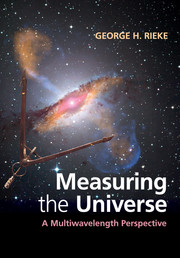Book contents
- Frontmatter
- Contents
- Preface
- 1 Radiometry, optics, statistics
- 2 Telescopes
- 3 Detectors for the ultraviolet through the infrared
- 4 Optical and infrared imaging; astrometry
- 5 Photometry and polarimetry
- 6 Spectroscopy
- 7 Adaptive optics and high-contrast imaging
- 8 Submillimeter and radio astronomy
- 9 Interferometry and aperture synthesis
- 10 X- and gamma-ray astronomy
- 11 Epilogue: cosmic rays, neutrinos, gravitational waves
- Appendix A Useful constants
- Appendix B Common Fourier transforms and relations
- References
- Index
- References
4 - Optical and infrared imaging; astrometry
Published online by Cambridge University Press: 05 November 2012
- Frontmatter
- Contents
- Preface
- 1 Radiometry, optics, statistics
- 2 Telescopes
- 3 Detectors for the ultraviolet through the infrared
- 4 Optical and infrared imaging; astrometry
- 5 Photometry and polarimetry
- 6 Spectroscopy
- 7 Adaptive optics and high-contrast imaging
- 8 Submillimeter and radio astronomy
- 9 Interferometry and aperture synthesis
- 10 X- and gamma-ray astronomy
- 11 Epilogue: cosmic rays, neutrinos, gravitational waves
- Appendix A Useful constants
- Appendix B Common Fourier transforms and relations
- References
- Index
- References
Summary
Imagers
Imagers capture the two-dimensional pattern of light at the telescope focal plane. They consist of a detector array along with the necessary optics, electronics, and cryogenic apparatus to put the light onto the array at an appropriate angular scale and wavelength range, to collect the resulting signal, and to hold the detector at an optimum temperature while the signal is being collected. Imaging is basic to a variety of investigations, but is also the foundation for the use of other instrument types that need to have their target sources located accurately. In this chapter we discuss the basic design requirements for imagers in the optical and the infrared and guidelines for obtaining good data and reducing it well. We finish with a section on astrometry, a particularly demanding and specialized use of images.
Optical imager design
A simple optical imager consists of a CCD in a liquid nitrogen dewar or cryostat with a window through which the telescope focuses light onto the CCD (see Figure 4.1). Broad spectral bands are isolated with filters, mounted in a wheel or slide to allow different ones to be placed conveniently over the window. Although this imager is conceptually simple, good performance requires attention to detail. For example, if the filters are too close to the CCD, any imperfections or dust on them will produce large-amplitude artifacts in the image.
- Type
- Chapter
- Information
- Measuring the UniverseA Multiwavelength Perspective, pp. 92 - 119Publisher: Cambridge University PressPrint publication year: 2012



